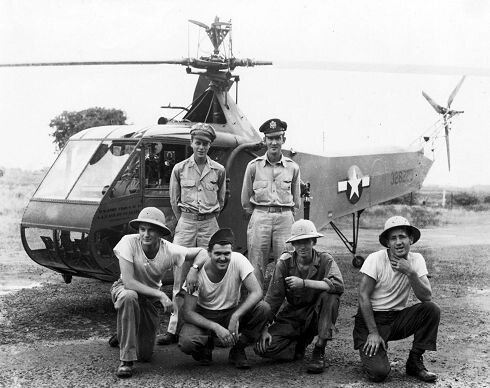 |
In April 1944, Staff Sgt. Ed "Murphy" Hladovcak, of the US Army Air Forces' 1st Air Commandos,, piloting a Vultee L-1 Vigilant liaison aircraft with three wounded British soldiers on board, was forced down in the jungle behind Japanese lines near Mawlu in Burma. With ground rescue forces days away and nowhere for an aeroplane to land, the men hid from nearby Japanese troops. A new US Army Sikorsky YR-4B helicopter, Ser.43-28247, flown by Lt. Carter Harman, was despatched to try a rescue. In the heat and humidity the YR-4B could carry only one passenger but, over 25-26 April 1944, four return trips were made to a nearby airstrip where the men transferred to an L-5 Sentinel. As the final trip began, shouting troops, fortunately from an Allied rescue group, emerged from the trees. |
|||
| US Air Force Museum photo (above), probably taken in January 1945, shows Lt.Carter Harman (standing left), with ground crew, including his crew-chief/mechanic, Sgt. Jim Phelan (front row right). Lt.Frank Peterson, a veteran R-4 test pilot who performed a later epic Burma rescue mission with a YR-4B, stands beside Lt.Harman. | ||||
| The Sikorsky YR-4B was made of fabric-covered, welded steel, tubes. A 7-cylinder Warner 180 hp R-550 radial engine was installed to the rear of the cabin. The main rotor measured 38 feet in diameter, having three fabric-covered blades with plywood ribs. The 3-bladed tail rotor was mounted on the starboard side, above a fixed tailwheel. The machine had two side-by-side seats in the cabin, with side doors, a maximum loaded weight of 2535lbs (1150kg), a cruising speed of 65mph, a 220 miles range and a service ceiling of 8000 ft. |
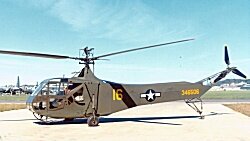 |
|||
Carter HarmanBorn in Brooklyn in 1918 Carter Harman began musical studies at school in New Jersey, playing the clarinet at the age of 9. He studied composition at Princeton, where he received his Bachelor's degree in 1940.He learned to fly small civil aircraft but, after Pearl Harbour, he joined the Army Air Forces. After gaining his wings 2nd Lt. Harman became an instructor, flying Waco PT-14 biplanes. He soon volunteered to train as a helicopter pilot at the Sikorsky plant at Bridgeport, Connecticut, with Sikorsky's test pilot, Jimmy Viner, as his flying instructor. His first solo flight, in the YR-4, was in October 1943 making him the seventh Army pilot to qualify. A few months later Lt.Harman was assigned to the 1st Air Commando Group who were operating in India, Burma and China supporting Brigadier Orde Wingate's 'Chindits'. On 16th March 1944 he arrived at the Air Commando base at Lalaghat, in India, with two other helicopter pilots. Ground staff arrived in C-46 transports carrying YR-4B helicopters as cargo. They were soon joined by Crew Chief Sgt. Jim Phelan, a mechanic who had been on Sikorsky training courses, at Bridgeport, with Lt.Harman. On 21st April 1944 one of the Air Commando's Vultee L-1 Vigilant observation aircraft, piloted by Staff Sgt. Ed 'Murphy' Hladovcak, was brought down behind the Japanese lines in Burma, while carrying three wounded British soldiers. A ground rescue or the use of another fixed-wing aircraft, were both considered impractical so it was decided that one of the YR-4Bs should attempt a rescue and that Carter Harman would fly it from Lalaghat, over a 5000ft mountain range, to the small 'Aberdeen' airstrip about 100km (60 miles) from the crash site. He had to make a 800km (500 mile) trip, mostly over Japanese controlled territory, with refueling stops every 100 miles. |
||||
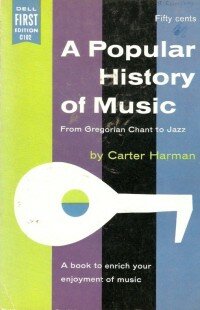 |
On 25th April, four days after the L-1B had been forced down, Lt.Harman flew his YR-4B to a clearing near the crash site and picked up the first of the British wounded. Having struggled, in the heat and humidity, to get the YR-4B into the air, Harman flew the soldier to a sandbar 17km (10 miles) away. There the wounded man was transferred to a Stinson L-5B which had brought fuel for the helicopter. Harman flew back to the jungle clearing and brought out a second soldier but was then forced to stay on the sandbar overnight to allow the engine to cool. The next day he went back for the third soldier and then for Sgt.Hladovcak. While performing his final departure from the clearing he noticed cheering troops coming out of the jungle towards them. Hours later he was told that these had been a Chindit overland rescue party. Lt.Harman flew another fifteen successful YR-4B evacuations from jungle areas, in the following weeks, until both the remaining machines became unserviceable through lack of spare parts. Harman received a Distinguished Flying Cross and, in September 1945, after the war had ended, he left the AAF, as a Captain. He returned to his musical studies at Columbia University, completing his Master's degree in 1949. He composed a number of simple children's songs which were recorded by Mary Martin and issued as an album entitled "Mary Martin Sings for Children". He went on to write a ballet in 1947 and an opera in 1949. While composing his opera Harman started to write profiles of jazz greats like Duke Ellington and Dave Brubeck and wrote "A Popular History of Music" in 1956. He worked for many years as a music critic, first for the New York Times and then, from 1952 until 1957, for Time magazine followed by ten years, partly spent in Puerto Rico, for Life magazine. While in Puerto Rico he also found time to be Sound Director on Peter Brook's "Lord of the Flies" (1963) and to write three books, including "The West Indies" for the 'Life World Library' series, in collaboration with his wife Helen Scott Harman. Carter Harman died in Stowe, Vermont, in January 2007, aged 88. His wife, Helen, had died in 1989. They had three sons and a daughter. |
|||
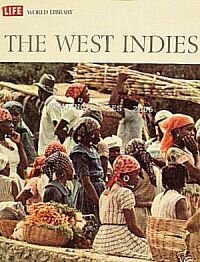 |
||||
|
|
||||
Jim PhelanJames D. Phelan's early life was spent in Stratford, Connecticut. He was drafted into the Army Air Force in 1942, after the Japanese attack on Pearl Harbour, and trained as an aircraft mechanic in Boston. On completion of training, in 1943, he was posted to a base in Indiana and worked on the maintenance of twin-engine Beech AT-10 training aircraft. Later in the year, when volunteers were called for, to train on helicopters, Phelan was sent to the Sikorsky plant at Stratford, Connecticut, his home town, where he met Carter Harman. |
||||
|
Soon after the end of the war Phelan was married to Marion. They had been together for 40 years when she died in 1986. In 1987 he married Jean Ross Howard, who had been, in 1954, one of the first women in America to qualify as a helicopter pilot and who had founded the Whirly-Girls, an international organisation of women helicopter pilots, in 1955. Phelan died at his home in Washington DC on 16th May 2006, just over two years after his wife died, aged 87, in January 2004. The family requested that, instead of flowers, donations in his memory should be sent to the Whirly-Girls Scholarship Fund. The family considered scattering his ashes from a helicopter but decided against it. Some weeks later there was a memorial service, for Jim Phelan, in Bridgeport, Connecticut. He was survived by three daughters and two sons, from his first marriage. |
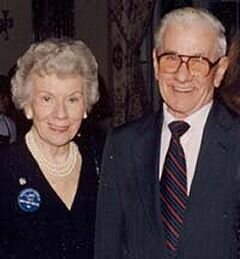 |
|||
Ed "Murphy" HladovcakEdward F. Hladavcak was known as "Murphy" in the Army because, understandably, few of his comrades seemed able to pronounce his real name. Aged 23 he was assigned, as a sergeant pilot, to the 1st Air Commandos in 1944, to fly Vultee L-1 Vigilant and Stinson L-5 Sentinel unarmed liaison aircraft on the India/Burma border during World War II.On 21st April 1944 he had picked up three wounded British soldiers, from behind the Japanese lines in Burma but, on his way back to base, his L-1 was hit by Japanese anti-aircraft fire and he had to make a forced landing in a rice paddy, still 100 miles inside Japanese-held jungle. Another liaison aircraft, an L-5 Sentinel, located Hladovcak's party but was unable to land in the waterlogged terrain. "Murphy" and the three wounded soldiers managed to crawl away from the wrecked L-1 and into the jungle, to hide from the Japanese soldiers who had been sent to investigate the crash site. |
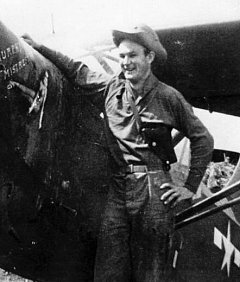 |
|||
|
The four exhausted men remained hidden in the jungle, for four more days, suffering intense heat and humidity with very little to eat. The condition of the soldiers rapidly worsened as their wounds became infected. They were plagued by swarms of mosquitoes, which were known to carry a virulent strain of malaria. Eventually L-5 Sentinels dropped supplies to them with a message telling Hladovcak of a nearby clearing where a helicopter would attempt to pick them up.
Lt.Carter landed the YR-4B, at the 'Aberdeen' airstrip, early on 25th April, re-fuelled and headed for the clearing guided by another L-5. He flew four round trips over two days, ferrying one man at a time, the last being Sgt.Hladovcak, from the clearing to a sand bar where they were picked up by the L-5 Sentinel and flown to the 'Aberdeen' camp. Soon after the end of the war Ed Hladovcak is believed to have run 'Sandhills Airways' from an airfield near Gordon, Nebraska, and to have owned a hangar and office buildings on the site. In the 1960s he worked for the U.S. Air Force as a flying instructor and as a helicopter test pilot. |
||||
| On 8th April 2009 The Helicopter Museum unveiled an exhibition, "The Carter Harman Story", which narrated the chain of events leading up to the 1944 helicopter rescues in Burma. The displays, with story boards, diagrams, photographs and several artefacts, were set in a tropically-themed environment with jungle sounds and a descriptive audio soundtrack. "The Carter Harman Story" ran until 30th September 2009. | ||||